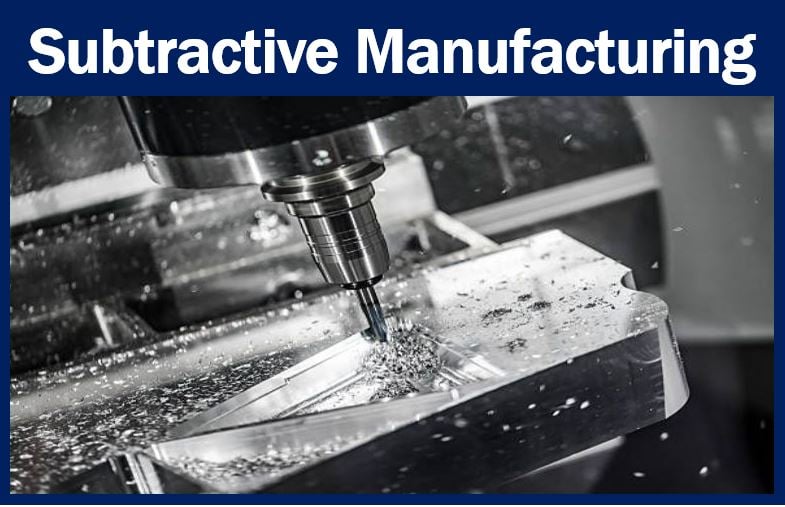Subtractive Manufacturing or Subtractive Fabrication involves cutting away from a solid block of material. It could be a block of, for example, metal, plastic, or wood. A milling machine cutting/hollowing out a piece of metal or plastic is an example of subtractive manufacturing.
Subtractive manufacturing by manually cutting the material is also possible. In fact, before the Industrial Revolution, that was how most of it was done.
This traditional form of manufacturing has evolved over centuries from simple handcrafting to sophisticated CNC machinery, reflecting the technological growth of society.
3DPrintingForBeginners.com has this simple but accurate definition of the term:
“Manufacturing processes based on controlled removal of undesired materials through cutting, drilling or milling to achieve the desired forms.”
It contrasts with additive manufacturing.

Additive vs. subtractive manufacturing
The adjective ‘subtractive’ means ‘tending to or able to remove or subtract.’ If something is subtractive, it takes things away.
The adjective ‘additive,’ on the other hand, means ‘tending to or able to add.’ If something is additive, it means that it adds things on.
-
Additive manufacturing
Additive manufacturing means creating three-dimensional objects by adding layer after layer. Since the turn of the century, additive manufacturing technology has advanced significantly. 3D printers today can even create jet engine turbines.
3D printing is a type of additive manufacturing.
-
Subtractive manufacturing
Subtractive manufacturing or ‘machining‘ involves cutting, hollowing, or taking parts out of a block of something.
Sculptors go through this process when they make statues. They start with a big block of stone or wood and gradually chisel away at it. Eventually, they have a statue of a man, woman, child, head, animal, etc.
Put simply; additive manufacturing involves adding layer (or bits) after layer (or bits). Subtractive manufacturing, on the other hand, involves taking away layer (or bits) after layer (or bits).
In manufacturing: with ‘subtractive,’ the object gets smaller as you progress. With ‘additive,’ it is the other way round – the object gets bigger as you progress.
Machinists
A person who operates machines in the subtractive manufacturing process is a machinist. Machinists work in a machine shop.
Subtractive manufacturing or machining is part of the manufacture of most metal products.
Gradually, CNC is replacing the human machinist. CNC stands for computer numerical control, in which a computer controls the movement and operation of subtracting machines such as lathes and mills.
MakePartsFast.com explains one advantage that subtractive manufacturing has over additive manufacturing:
“Besides eliminating the layering of additive processes, subtractive processes have other advantages. They offer a variety of surface finishes, doing away with the ‘stepped’ surfaces often found in many additive processes.”
“The finish can be functionally important if parts must slide and cosmetically important if the prototypes are to be used in market testing.”
However, milling undercuts are not always easy. Machining also tends to be more expensive than using an additive process.
Despite the higher costs, the precision of subtractive manufacturing makes it indispensable for creating complex parts with tight tolerances that additive methods cannot yet match.
“Subtractive Manufacturing,” vocabulary and concepts
There are many terms in business English related to the term “subtractive manufacturing.” Let’s have a look at some specific compound phrases, their meanings, and how we use them in a sentence:
-
Subtractive Manufacturing Techniques
The various methods used in the subtractive process to shape materials.
Example: “The workshop implemented advanced subtractive manufacturing techniques to improve the precision of their parts.”
-
Subtractive Manufacturing Equipment
The tools and machinery used for subtractive processes.
Example: “Investing in state-of-the-art subtractive manufacturing equipment has significantly increased our production capacity.”
-
Subtractive Manufacturing Costs
The expenses associated with the subtractive process of making products.
Example: “Subtractive manufacturing costs are being closely analyzed to identify areas for financial efficiency.”
-
Subtractive Manufacturing Workflow
The sequence of operations in subtractive processes from start to finish.
Example: “The team streamlined the subtractive manufacturing workflow to reduce turnaround time.”
-
Subtractive Manufacturing Precision
The accuracy and exactness attainable with subtractive manufacturing.
Example: “Our clients choose us for the subtractive manufacturing precision we guarantee in every product.”
-
Subtractive Manufacturing Innovation
The development of new methods and technologies in subtractive manufacturing.
Example: “The company has been recognized for its subtractive manufacturing innovation, particularly in the area of material conservation.”
Two Educational Videos
These two interesting videos come from our sister channel on YouTube – Marketing Business Network. One explains what “Subtractive Manufacturing” is, and the other is all about “Manufacturing.” Both videos use easy-to-understand vocabulary and examples.
-
What is Subtractive Manufacturing?
-
What is Manufacturing?
